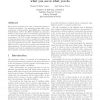Free Online Productivity Tools
i2Speak
i2Symbol
i2OCR
iTex2Img
iWeb2Print
iWeb2Shot
i2Type
iPdf2Split
iPdf2Merge
i2Bopomofo
i2Arabic
i2Style
i2Image
i2PDF
iLatex2Rtf
Sci2ools
ICRA
2003
IEEE
2003
IEEE
Visual transformations in gesture imitation: what you see is what you do
We propose an approach for a robot to imitate the gestures of a human demonstrator. Our framework consists solely of two components: a Sensory-Motor Map (SMM) and a View-Point Transformation (VPT). The SMM establishes an association between an arm image and the corresponding joint angles and it is learned by the system during a period of observation of its own gestures. The VPT is widely discussed in the psychology of visual perception and is used to transform the image of the demonstrator’s arm to the so-called ego-centric image, as if the robot were observing its own arm. Different structures of the SMM and VPT are proposed in accordance with observations in human imitation. The whole system relies on monocular visual information and leads to a parsimonious architecture for learning by imitation. Real-time results are presented and discussed.
Corresponding Joint Angles | Human Demonstrator | ICRA 2003 | Robotics | So-called Ego-centric Image |
| Added | 04 Jul 2010 |
| Updated | 04 Jul 2010 |
| Type | Conference |
| Year | 2003 |
| Where | ICRA |
| Authors | Manuel Cabido-Lopes, José Santos-Victor |
Comments (0)

